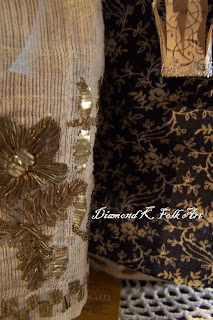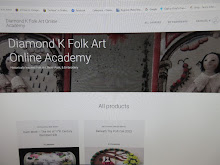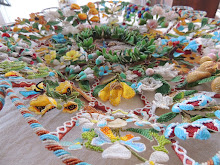Looking foreword to the Holidays...
I have been trying to tidy things up a bit....I put the tree up in
the gallery last week or so, but still have
Halloweenies that want
to stay out and play!! We normally put up a couple of trees for
Christmas in the house, and then decorate at least one outside for
the animals. I love the Christmas tree, it just may be my favorite
thing about Christmas...besides watching the children on
Christmas morning. When I was little, Ma & Pa let my brother
and I have our own tree in our Bedroom....always decorated with
the neat things we made at school....I particularly liked, and can
remember, the HUGE ornaments we made one year, from a
Christmas card glued onto a foam meat tray(that the meat would
come on from the grocery store)...then we put all sorts of glitter
and such around the outside. Golly I was
prolly in the 2
nd grade
or so. I have always been a 'gatherer', and I still have several of
the ornaments I made when I was little.....I even still have the
little red felt stocking my
kindergarten teacher made for me,
that has my name
spelt hideously wrong....but I LOVE it! I can
remember going to school, and looking all over the tree for 'mine',
and seeing the little red candy cane she put in it.....
ohhh it was so
hard to wait to finally e*a*t* it! I wonder if I would still
remember that, if I
didn't still have the little stocking to keep it
fresh in my memory? I think that is why I love the Christmas
tree so much- I keep all my most precious memories there.
 Wixie
Wixie loves
the tree too and
couldn't stop hopping up and down
until I took her picture in front of it. I told her the memory
attached to each one as we hung them on. Do you see the
nutcracker to the right of her? My Mom made that when I was
in my teens- a cross stitched band, then she stitched it into a tube
and stuffed it. I can remember her making it. I also keep special
ornaments on that my friends have made and given to me, like
the red stripe star with little painted face from Lorraine of
Piecake Primitives.

Here she is studying one of
Joshies pictures he had taken with
the dept store Santa one year....I like to make little paper frames
for them and hang them on the tree. You can make a very special
ornament by letting your child draw a picture- like of a star or
snowman....make sure its big enough to cut a piece out for the
picture to slip behind....then cut it out and hang it on the tree.
They can color it and add their own glitter and such-

I LOVE the little ones the children make me at school each year.
You can see one of Emma she made all by herself last year, it was
my Christmas gift and I adore it, big red pipe cleaners and all!
The little soldier
to the left of the Wish star I made, is made
from porcelain made from Mt. St. Helen's ash, the
volcano that
erupted May 18
th, 1980 in
Wa state.....I can still remember
playing in the front yard wondering why it was 'snowing' in the
summer??
 Wixie
Wixie wants to be a part of my tree too, so I told her she could,
as long as she could be still.....which I suppose wont be for long!
Can you imagine getting a
dollye for Christmas, and finding her
hiding in
the tree on Christmas morn? How FUN that would be!
Actually, I think I like the look of her peeking out at me,
maybe I
will have to do a
dollye tree next year?
hmmmmmmm
Grete (pronounced Greet), is telling me I need to get back to
work!
Doesn't she look wonderful up on the sweet meat tier with
my white Christmas tree ornaments? I know
I'm not the only
early bird when it comes to decorating for Christmas, so I hope
you all take time to enjoy your decorating,
don't forget to set
aside a little extra for remembering






















 Both are special
Both are special 
 This mid 1840 daguerreotype shows the Dennis Brothers and their sister quietly figuring a cypher on
This mid 1840 daguerreotype shows the Dennis Brothers and their sister quietly figuring a cypher on  This boys tunic is made for winter wear, as it is fully wadded in both the chest and skirting, as well as full length of the arms. This would fit a boy, depending on build, of about 5-7 years old. The outer silk is
This boys tunic is made for winter wear, as it is fully wadded in both the chest and skirting, as well as full length of the arms. This would fit a boy, depending on build, of about 5-7 years old. The outer silk is 


 On this view you can see on
On this view you can see on 






















